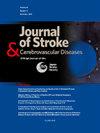Rate and predictors of white matter disease volume progression across different age groups
IF 2
4区 医学
Q3 NEUROSCIENCES
Journal of Stroke & Cerebrovascular Diseases
Pub Date : 2025-04-25
DOI:10.1016/j.jstrokecerebrovasdis.2025.108329
引用次数: 0
Abstract
Background and Objectives
White matter disease (WMD) is common among aging populations and is associated with adverse neurological outcomes. While age is a known risk factor for WMD burden, the precise relationship between age and the rate of WMD volume progression remains unclear. The purpose of this study is to investigate the age-dependent acceleration of WMD volume progression across different age groups and its potential clinical implications.
Methods
This retrospective study included 2356 patients aged 40 years or older who underwent longitudinal MRI brain scans between 2011 and 2019 at Mayo Clinic. Baseline demographic and clinical characteristics, including vascular risk factors, were collected. The primary outcome was the annual rate of WMD volume progression, which was analyzed across the five age groups (40-49, 50-59, 60-69, 70-79, and 80-99 years). Analysis of Covariance (ANCOVA) assessed the effect of different age groups on WMD progression, while linear ridge regression was used to identify predictors of WMD progression.
Results
The mean age of the cohort was 67.6 ± 11.5 years, with 52.7 % female and 95.1 % White. The baseline WMD volume averaged 13.05 ± 14.49 cm³, increasing to 18.30 ± 17.10 cm³ after a median follow-up of 4.8 years, corresponding to an annual progression rate of 1.19 ± 3.01 cm³/year. The annualized rate of WMD volume progression increased significantly with age, from 0.39 cc/year in the 40-49 age group to 1.63 cc/year in the 80-99 age group (p < 0.001). Additionally, the linear ridge regression model identified age, female sex, ever-smoker, diabetes, and baseline WMD volume as significant predictors of faster WMD progression (p < 0.05).
Conclusion
Our study revealed a significant age-dependent acceleration in WMD volume progression. Age, female sex, ever smoker, diabetes, and baseline WMD volume emerged as significant predictors of the rate of WMD volume progression.
不同年龄组白质疾病体积进展的比率和预测因素
背景与目的白质病(WMD)在老年人群中很常见,并与不良的神经系统预后相关。虽然年龄是已知的大规模杀伤性武器负担的危险因素,但年龄与大规模杀伤性武器体积进展率之间的确切关系尚不清楚。本研究的目的是探讨不同年龄组WMD体积进展的年龄依赖性加速及其潜在的临床意义。方法本回顾性研究包括2356名年龄在40岁及以上的患者,他们于2011年至2019年在梅奥诊所接受了纵向MRI脑部扫描。收集基线人口统计学和临床特征,包括血管危险因素。主要终点是WMD体积进展的年速率,对5个年龄组(40-49岁、50-59岁、60-69岁、70-79岁和80-99岁)进行分析。协方差分析(ANCOVA)评估了不同年龄组对WMD进展的影响,而线性脊回归用于确定WMD进展的预测因子。结果患者平均年龄为67.6±11.5岁,女性占52.7%,白人占95.1%。基线WMD体积平均为13.05±14.49 cm³,中位随访4.8年后增加到18.30±17.10 cm³,相当于年进展率为1.19±3.01 cm³/年。WMD体积进展的年化率随着年龄的增长而显著增加,从40-49岁年龄组的0.39 cc/年增加到80-99岁年龄组的1.63 cc/年(p <;0.001)。此外,线性脊回归模型发现,年龄、女性、吸烟史、糖尿病和基线WMD体积是WMD更快进展的重要预测因素(p <;0.05)。结论我们的研究显示WMD体积进展明显的年龄依赖性加速。年龄、女性、曾经吸烟、糖尿病和基线WMD体积是WMD体积进展速度的重要预测因素。
本文章由计算机程序翻译,如有差异,请以英文原文为准。
求助全文
约1分钟内获得全文
求助全文
来源期刊

Journal of Stroke & Cerebrovascular Diseases
Medicine-Surgery
CiteScore
5.00
自引率
4.00%
发文量
583
审稿时长
62 days
期刊介绍:
The Journal of Stroke & Cerebrovascular Diseases publishes original papers on basic and clinical science related to the fields of stroke and cerebrovascular diseases. The Journal also features review articles, controversies, methods and technical notes, selected case reports and other original articles of special nature. Its editorial mission is to focus on prevention and repair of cerebrovascular disease. Clinical papers emphasize medical and surgical aspects of stroke, clinical trials and design, epidemiology, stroke care delivery systems and outcomes, imaging sciences and rehabilitation of stroke. The Journal will be of special interest to specialists involved in caring for patients with cerebrovascular disease, including neurologists, neurosurgeons and cardiologists.
 求助内容:
求助内容: 应助结果提醒方式:
应助结果提醒方式:


